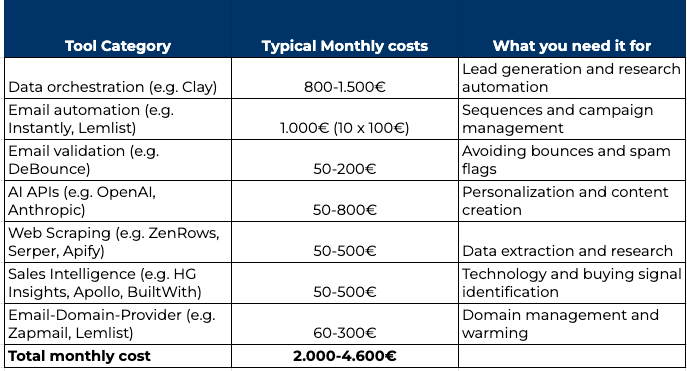While LinkedIn is full of success stories about the latest AI tools and no-code platforms for sales teams, one critical point is systematically ignored: The skyrocketing costs of sales infrastructure.
At Scalantec, we see it every day: companies focus on sales headcounts and forget the technology costs that are incurred per capita. But in the new world of technology-driven sales, this blind spot can quickly become an incalculable cost factor.
The truth: A modern B2B sales setup can quickly cost you several thousand euros per month — even before the first euro of turnover is generated.
The true cost of the modern sales stack
The Clay Trap — A Prime Example
Let's take Clay as an example — the tool that we ourselves use and love every day. At first glance, the prices seem manageable. But the reality is different:
- For serious B2B outbound, the credits in the starter plan are used up within a few days
- Only from around 800€ monthly fixed costs Will it be cost-effective with the Pro plan
- Most companies dramatically underestimate their credit consumption
What is often lost in sales tool pitches: Running costs increase with your success. The more leads you generate, the more expensive the infrastructure becomes.
The complete stack — The true cost table

The agency advantage: Why outsourcing is often cheaper
This is where the key point comes in: A specialized outbound agency such as Scalantec distributes these infrastructure costs to all customers.
A real example:
One of our customers from the logistics tech sector originally calculated:
- In-house setup: 5 FTE sales development reps (25,000€ monthly including additional costs)
- Plus sales tools (estimated €1,000 per month)
The reality after 3 months:
- Actual tool costs: 2.950€ monthly (€1,200 Clay + €500 Email Automation + €100 Email Validation + €350 AI APIs + €100 Web Scraping + €100 Sales Intelligence + €100 Email Domain Provider)
- Inefficient use due to lack of expertise
- Significantly fewer meetings than expected
After switching to Scalantec:
- Comparable total monthly costs
- 3x more qualified meetings
- No hidden tool costs or surprises
The reason: We use the same tech stack for several customers at the same time — and have the expertise to make optimal use of it.
Hybrid models: The best of both worlds
For many of our customers, we have developed a hybrid setup that combines the benefits of both approaches. The customer uses their own clay account, keeping full control of data orchestration while we connect our extensive databases and additional tools via APIs.
This saves the customer the high fixed costs for specialized data tools while maintaining control over their data. This model has proven particularly effective for companies that already have experience with Clay but want to benefit from the expertise and combined resources of a specialized agency.
Renting Ferrari instead of buying: The new sales logic
The most accurate analogy comes from one of our customers: “It's like a Ferrari. I can buy all the tools I need to service it — or I can simply rent a professional garage when I need it.”
This logic explains why more and more B2B companies are outsourcing their outbound activities:
- Cost sharing: Infrastructure costs are spread across several customers
- Expertise advantage: Specialized teams know exactly how to use the tools optimally
- scalability: Quick start-up and shutdown without long-term commitments
- Timeliness: Constant access to the latest tools without your own evaluation
The make-or-buy decision: When your own stack is worthwhile
Does that mean that no company should build their own sales stack anymore? Not necessarily. There are scenarios in which the investment is worthwhile:
- For highly specialized niches that require very specific tools
- When sales technology is a strategic competitive advantage
For everyone else — particularly scale-ups and SMEs with limited technology expertise — outsourcing or at least a hybrid model is often the more cost-effective option.
Three strategies for cost-effective sales infrastructure
Regardless of which path you choose, here are three strategies to keep infrastructure costs under control:
- Exact needs analysis: Create a detailed list of all the tools you need and how to actually use them. Many companies buy features they never use.
- Hybrid model: Start with outsourcing to get to know the tools and then bring strategic components in-house step by step.
- Consolidation: Look for all-in-one solutions that cover multiple features. They are often more expensive than individual tools, but cheaper than the entire stack.
Conclusion: Make the hidden costs visible
Modern B2B sales are becoming increasingly technology-intensive — and therefore also more cost-intensive on the infrastructure side. The smartest sales leaders make this hidden cost trap visible and make conscious make-or-buy decisions.
At Scalantec, we not only help companies with outbound generation, but also advise on the optimal use of sales technology — whether in-house or as a service.
Do you want to know what your ideal sales stack could look like and how much it would actually cost you? Arrange a non-binding conversation — we'll show you how to find the perfect balance between technology investment and outsourcing.
Moritz Heininger is co-founder of Scalantec. He has extensive experience in strategic consulting and managing global tech companies. Moritz previously worked as Managing Director at Tink Labs (Softbank Venture), Chief Operating Officer at Anchanto (e-commerce SaaS), Managing Director at foodpanda (Rocket Internet) and founder of DIDIT (VC-financed payment company). His expertise in application-related AI solutions and strategic business management helps Scalantec customers transform their go-to-market strategies.


